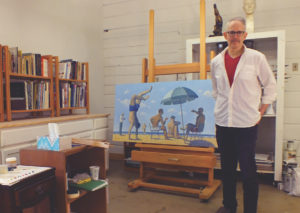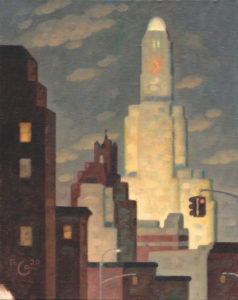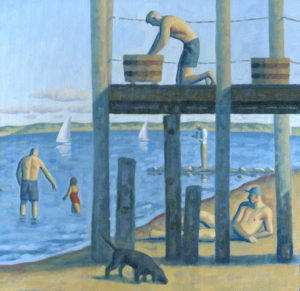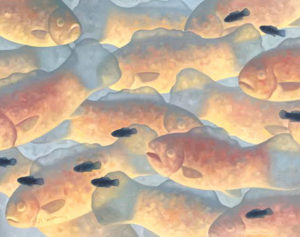
“I am generally a rather high-strung, tense person, anal retentive,” Robert Goldstrom says, speaking from his home in Claverack, N.Y., near Hudson, in the Hudson River Valley. “Compared to most painters, my work is fairly tight.”
Goldstrom is not making excuses — it’s more a form of self-awareness. And when it comes to his art, he’s correct: his work is tight. His images are representational, but there’s caricature and style to his figures. Edges seem rounded and modern. His colors are rich yet subtle.
Art lovers on the Outer Cape will be able to sample a variety of his paintings at Rice Polak Gallery in Provincetown as of Thursday, Aug. 20. Goldstrom is part of a group show there, which will be on view through Sept. 3.

Compare his work to Grant Wood’s and that of other early to mid-20th-century American painters, and Goldstrom sees the connection immediately. His knowledge of art history is encyclopedic. He cites other influences. “I’ve always loved the Dutch Renaissance,” he says. “Petrus Christus. Pieter de Hooch. Vermeer is loose compared to most of these guys. They’re immaculate. You can’t see a brushstroke. It’s just so perfect, it can be annoying. Something in my brain loves that stuff.”
Goldstrom sees himself as a realist painter, though he distinguishes realism from naturalism, which is simply a mirror reflection of what’s out there. Realism, for Goldstrom, allows some measure of expression.
“Leonardo da Vinci, say, is a realist,” he says. “Everything is recognizable, but there’s a stylization going on. It gives him the capability to invent things. Most of what I do is not literal. It’s not a snapshot. It’s an interpretation.”
Goldstrom’s approach is rooted in his early work as an illustrator. He grew up in Detroit and went to the University of Michigan, where he earned a B.A. in English. After school, he worked six months in an art studio near Detroit, doing ads and design work, mostly for the auto industry. “I was an apprentice,” he says. “They called me a junior illustrator.”
He moved to Chicago, where he did illustrations for Playboy, and eventually to New York, where he worked successfully as a freelance illustrator. Among other jobs, he did posters for the New York City Opera.

He started painting in oil in the 1980s, and by the late ’90s, he was largely doing paintings for sale at galleries, not commercial assignments. David Sokosh, now his husband, is a photographer; they showed together at a gallery that Sokosh ran in the Dumbo neighborhood of Brooklyn, near where they lived.
They also rented a house year-round in Provincetown at that time, and Goldstrom enjoyed working here in the quiet of winter. He showed at A Gallery, and later at Adam Peck Gallery, mostly paintings from his “Anatomy” series.
Goldstrom likes painting in series, with each successive work representing a new idea in the same thread. Doing the “Anatomy” series, he would sometimes do portraits of body parts: just hands, for example. Much of the series was male figure paintings, and that put him on the map in Provincetown.
Even as “a proud gay man,” Goldstrom says he isn’t really interested in homoeroticism. His “Anatomy” paintings were about “the arrangement of the bodies. You don’t see faces. You’re not going to look at them and get warm and fuzzy about the people. That says something about me: they’re detached. It’s using the male body as a source of abstract qualities — the light and the rhythm, intersecting forms.”
Goldstrom has done other series, a few of which will be represented in the Rice Polak show. There’s his “Beach” series, including an exultant Running Women and another piece, of people on or about a Provincetown-like wharf, called Planter, which resembles Seurat’s A Sunday Afternoon on the Island of La Grand Jatte.
Then, there’s his “Bank” series of Brooklyn cityscapes, all of which depict the iconic Williamsburg Savings Bank Tower. Finally, and most unique and intriguing, is his “Aquaria” series, of people observing fish at an aquarium, and, perhaps, fish observing people.

The light in these paintings draws you in — they are lit from below. “In most paintings, the light comes from the top,” Goldstrom says. “I liked the idea of the light bouncing up from below. It gives it an otherworldly look.”
He insists that his paintings have to be about something, and the “Aquaria” series, with its unusual cross-species points of view and invisible glass separation, is a key example of that.
“I don’t explore consciously what’s going on there,” Goldstrom says. “It may not be narrative like a crucifixion. It may not be that defined a story. But there are relationships that are being explored. Sometimes, I can’t tell you what those relationships are. Sometimes, I don’t want to tell you. I owe it to the viewer to give 51 percent of what’s going on. That allows me to have some mystery.”
As anal retentive as Goldstrom claims to be, he acknowledges that art, for him, is a creative necessity. “There are things in my head that have to come out,” he says. “Whatever creative endeavor it may be. I still think I might become a writer. I’m more of an editor in my painting. My artwork wants to be concise. Tight, controlled editing. There’s a lot of me in that.”
Good as Goldstrom
The event: Exhibit of new work by Robert Goldstrom, part of a group show with Blair Bradshaw, Jennifer Goldfinger, and Michael Snodgrass
The time: Thursday, Aug. 20, through Sept. 3; daily, noon to 5 p.m., Friday and Saturday evenings, and by appointment
The place: Rice Polak Gallery, 430 Commercial St., Provincetown
The cost: Free



